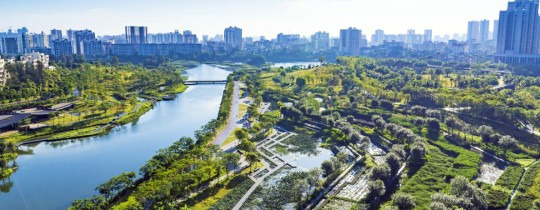Sponge Cities: A Revolutionary Approach to Urban Water Management

In the face of escalating climate change, innovative solutions are needed more than ever. One such solution is the concept of 'Sponge Cities’, pioneered by Kongjian Yu, founder of Turenscape, a leading Chinese landscape architecture and urbanism practice.
Understanding Sponge Cities
The term 'Sponge City’ refers to an urban area designed to absorb, clean, and use rainwater through natural landscapes. This concept is a radical departure from traditional 'grey infrastructure’ approaches, which often involve swiftly channeling rainwater away through concrete channels and steel pipes.
In a Sponge City, rainwater is seen as a valuable resource rather than a problem. The city is designed to catch rainwater, slow down its flow, and clean it through biological processes. This water can then be stored for use during dry seasons, reducing the city’s reliance on traditional water sources and increasing its resilience to droughts.
The Role of Rainwater
Rainwater is at the heart of the Sponge City concept. By changing how we manage rainwater, we can create cities that are more resilient to climate change, more sustainable, and more in harmony with nature. Sponge Cities use their natural resources to absorb rainwater and release it more slowly into lakes and rivers, helping to prevent flooding.
The Technical Brilliance of Sponge Cities
What makes the Sponge City concept technically brilliant is its simplicity and effectiveness. It uses nature’s own mechanisms to manage water, reducing the need for expensive and often ineffective man-made drainage systems.
Moreover, by slowing down the flow of water, it allows more time for it to seep into the ground, replenishing groundwater supplies. This is particularly important in cities where groundwater levels are dropping due to over-extraction.
Successful Implementations of Sponge Cities
Several cities around the world have successfully implemented the Sponge City concept:
- Zhenjiang, Xiamen, and Shenzhen, China: These cities have showcased how policy support can catalyze large-scale urban ecological transformations.
- Auckland, New Zealand: Auckland has a 35% sponge rating, largely thanks to its stormwater systems, many golf courses, green parks, and good-sized residential gardens.
- Harbin, China: The 34-hectare 'Qunli stormwater park’ in Harbin is a successful example of a Sponge City. It collects, cleanses, and stores stormwater, while also protecting the native natural habitat and providing a beautiful green public space for recreational use.
Conclusion
The Sponge City concept offers a promising approach to tackling the challenges posed by climate change. By integrating nature-based solutions with modern technologies, we can build cities that are not only more resilient but also more harmonious with the natural environment. This innovative idea, conceived by Kongjian Yu, aims to address and prevent urban flooding in the context of accelerated climate change. It’s not just about managing water; it’s about creating sustainable, resilient, and livable cities for the future. The IRHA’s Urban Rainwater programme is a testament to the growing recognition of the importance of sustainable urban water management.
credits: image by Turenscape